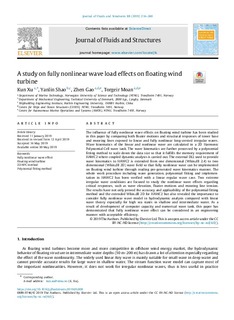| dc.contributor.author | Xu, Kun | |
| dc.contributor.author | Shao, Yanlin | |
| dc.contributor.author | Gao, Zhen | |
| dc.contributor.author | Moan, Torgeir | |
| dc.date.accessioned | 2019-08-29T11:39:33Z | |
| dc.date.available | 2019-08-29T11:39:33Z | |
| dc.date.created | 2019-06-11T08:59:48Z | |
| dc.date.issued | 2019 | |
| dc.identifier.citation | Journal of Fluids and Structures. 2019, 88, 216-240. | nb_NO |
| dc.identifier.issn | 0889-9746 | |
| dc.identifier.uri | http://hdl.handle.net/11250/2611621 | |
| dc.description.abstract | The influence of fully nonlinear wave effects on floating wind turbine has been studied in this paper by comparing both floater motions and structural responses of tower base and mooring lines exposed to linear and fully nonlinear long-crested irregular waves. Wave kinematics of the linear and nonlinear wave are calculated in a 2D Harmonic Polynomial Cell wave tank. The wave kinematics are further processed by a polynomial fitting method to scale down the data size so that it fulfills the memory requirement of HAWC2 where coupled dynamic analysis is carried out. The external DLL used to provide wave kinematics to HAWC2 is extended from one dimensional (Wkin.dll 2.4) to two dimensional (Wkin.dll 2D) wave field so that fully nonlinear wave can be implemented on floating wind turbine through reading pre-generated wave kinematics manner. The whole work procedure including wave generation, polynomial fitting and implementation in HAWC2 has been verified with a linear regular wave case. Two extreme irregular wave conditions are focused to study the nonlinear wave effects regarding critical responses, such as wave elevation, floater motions and mooring line tension. The results have not only proved the accuracy and applicability of the polynomial fitting method and the extended Wkin.dll 2D for HAWC2 but also revealed the importance to consider fully nonlinear wave model in hydrodynamic analysis compared with linear wave theory especially for high sea states in shallow and intermediate water. As a result of development of computer capacity and numerical wave tank, this paper has demonstrated that fully nonlinear wave effect can be considered in an engineering manner with acceptable efficiency. | nb_NO |
| dc.language.iso | eng | nb_NO |
| dc.publisher | Elsevier | nb_NO |
| dc.rights | Attribution-NonCommercial-NoDerivatives 4.0 Internasjonal | * |
| dc.rights.uri | http://creativecommons.org/licenses/by-nc-nd/4.0/deed.no | * |
| dc.title | A study on fully nonlinear wave load effects on floating wind turbine | nb_NO |
| dc.type | Journal article | nb_NO |
| dc.type | Peer reviewed | nb_NO |
| dc.description.version | publishedVersion | nb_NO |
| dc.source.pagenumber | 216-240 | nb_NO |
| dc.source.volume | 88 | nb_NO |
| dc.source.journal | Journal of Fluids and Structures | nb_NO |
| dc.identifier.doi | 10.1016/j.jfluidstructs.2019.05.008 | |
| dc.identifier.cristin | 1703819 | |
| dc.description.localcode | © 2019 The Authors. Published by Elsevier Ltd. Open Access CC-BY-NC-ND | nb_NO |
| cristin.unitcode | 194,64,20,0 | |
| cristin.unitname | Institutt for marin teknikk | |
| cristin.ispublished | true | |
| cristin.fulltext | original | |
| cristin.qualitycode | 1 | |

